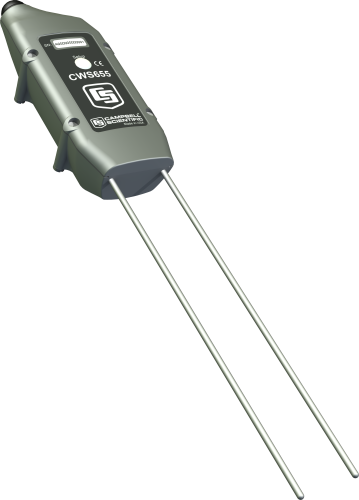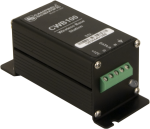This product is not available for new orders.

| Services Available |
|---|
Resumen
The CWS655E is a wireless version of our CS655 soil water reflectometer. It has 12 cm rods and monitors soil volumetric water content, bulk electrical conductivity, and temperature. This reflectometer has an internal 868 MHz spread-spectrum radio that transmits data to a CWB100E Wireless Base Station or to another wireless sensor. The 868 MHz frequency is commonly used in Europe.
Leer másVentajas y características
- Sensor versátil—mide la permitividad dieléctrica, conductividad eléctrica (EC), y temperatura del suelo
- Medida corregida para efectos de la textura del suelo y conductividad eléctrica
- Radio spread spectrum con frequency-hopping interior, que ofrece mayor alcance y menos interferencia
- Método fiable, con bajo mantenimiento y consumo, para realizar medidas en aplicaciones en que los sensores con cable no son prácticos o indeseados
- Las transmisiones pueden enrutarse a través de hasta otros tres sensores inalámbricos
- Alimentado por batería
- Compatible con dataloggers CR300, CR800, CR850, CR1000 y CR3000
Imágenes

Descripción detallada
The CWS655E has 12-cm rods that insert into the soil. It measures propagation time, signal attenuation, and temperature. Dielectric permittivity, volumetric water content, and bulk electrical conductivity are then derived from these raw values.
Measured signal attenuation is used to correct for the loss effect on reflection detection and thus propagation time measurement. This allows accurate water content measurements in soils with bulk ≤3.7 dS m-1 without performing a soil-specific calibration.
Soil bulk electrical conductivity is also derived from the attenuation measurement. A thermistor in thermal contact with a probe rod near the epoxy surface measures temperature. Horizontal installation of the sensor provides accurate soil temperature measurement at the same depth as the water content measurement. For other orientations, the temperature measurement will be that of the region near the rod entrance into the epoxy body.
Why Wireless?
There are situations when it is desirable to make measurements in locations where the use of cabled sensors is problematic. Protecting cables by running them through conduit or burying them in trenches is time consuming, labor intensive, and sometimes not possible. Local fire codes may preclude the use of certain types of sensor cabling inside of buildings. In some applications measurements need to be made at distances where long cables decrease the quality of the measurement or are too expensive. There are also times when it is important to increase the number of measurements being made but the datalogger does not have enough available channels left for attaching additional sensor cables.
Productos similares
Preguntas frecuentes
Número de FAQs relacionadas con CWS655E: 31
Expandir todoDesplegar todo
-
To get accurate water content readings, a soil-specific calibration is probably required if any of the following are true:
- The soil has more than 5% organic matter content.
- The soil has more than 20% clay content.
- The soil is derived from volcanic parent material.
- The soil has porosity greater than 0.5.
For details on performing a soil-specific calibration, refer to “The Water Content Reflectometer Method for Measuring Volumetric Water Content” section in the CS650/CS655 manual.
Some users have obtained good results by applying a linear correction to the square root of reported permittivity before applying the Topp et al. (1980) equation. The linear correction is obtained by taking readings in saturated and dry soil and using volumetric water content measurements obtained from oven-dried soil samples to estimate actual permittivity.
-
No. The abrupt permittivity change at the interface of air and saturated soil causes a different period average response than would occur with the more gradual permittivity change found when the sensor rods are completely inserted in the soil.
For example, if a CWS655 was inserted halfway into a saturated soil with a volumetric water content of 0.4, the probe would provide a different period average and permittivity reading than if the probe was fully inserted into the same soil when it had a volumetric water content of 0.2.
-
Damage to the CWS655 electronics or rods cannot be repaired because these components are potted in epoxy. A faulty or damaged sensor needs to be replaced. For more information, refer to the Repair and Calibration page.
-
No. The temperature sensor is located inside the sensor’s epoxy head next to one of the sensor rods. The stainless-steel rods are not thermally conductive, so the reported soil temperature reading is actually the temperature of the sensor head near the soil surface.
Because the sensor is installed vertically with the sensor head above ground, the soil temperature reading is not representative of the temperature over the length of the 12 cm rods, but the reading is closer to the temperature of the soil surface. Because the temperature reading is not representative of the entire thickness of soil measured for water content, no attempt was made to correct the water content readings for temperature changes.
-
The dielectric of water at room temperature is close to 80. The firmware for the CWS655 is programmed to change volumetric water content to NAN when the permittivity measurements are greater than 42. When testing in water, look at the permittivity reading rather than the water content reading. If a test is being done for functionality, pull the CWS655 rods about halfway out of the water to see both permittivity and volumetric water content readings.
Note: The CWS655 was not designed for complete submersion in water. To conduct a water test, fully immerse the sensor rods in the water, but do not let the battery pack go under water.
-
The maximum recommended number in a Campbell Scientific wireless sensor network is 50.
-
No. The principle that makes the CWS655 work is that liquid water has a dielectric permittivity of close to 80, while soil solid particles have a dielectric permittivity of approximately 3 to 6. When liquid water freezes, its dielectric permittivity drops to 3.8, essentially making it look like soil particles to the CWS655. A CWS655 installed in soil that freezes would show a rapid decline in its volumetric water content reading with corresponding temperature readings that are below 0°C. As the soil freezes down below the measurement range of the sensor, the water content values would stop changing and remain steady for as long as the soil remains frozen.
-
Shortening the rods will void the warranty. There are several other reasons why Campbell Scientific strongly discourages shortening the sensor’s rods. The electronics in the sensor head have been optimized to work with the 12 cm long rods. Shortening these rods will change the period average. Consequently, the equations in the firmware will become invalid and give inaccurate readings.
-
Because the reported volumetric water content reading is an average taken along the entire length of the rods, the sensor should be fully inserted into the soil. Otherwise, the reading will be the average of both the air and the soil, which will lead to an underestimation of water content. If the sensor rods are too long to go all the way into the soil, Campbell Scientific recommends inserting the rods at an angle until they are fully covered by soil.
-
The CWS655 can detect water as far away as 10 cm in saturated sand. As the soil dries down, that distance decreases to approximately 4 cm in dry sand.
Compatibilidad
Nota: lo siguiente muestra información de compatibilidad notable. No es una lista de todos los productos compatibles.
Especificaciones
| Weather Resistance | IP67 rating for sensor and battery pack (Battery pack must be properly installed. Each sensor is leak tested.) |
| Rango temperatura funcionamiento | -25° to +50°C |
| Operating Relative Humidity | 0 to 100% |
| Power Source | 2 AA batteries with a battery life of 1 year assuming sensor samples taken every 10 minutes. (Optional solar charging available.) |
| Average Current Drain | 300 μA (with 15-minute polling) |
| Rod Length | 12 cm (4.7 in.) |
| Body Dimensions | 14.5 x 6 x 4.5 cm (5.7 x 2.4 x 1.77 in.) |
| Peso | 216 g (7.6 oz) |
Measurement Accuracies |
|
| Volumetric Water Content | ±3% VWC typical in mineral soils that have solution electrical conductivity ≤10 dS/m. Uses Topps Equation (m3/m3). |
| Relative Dielectric Permittivity |
|
| Bulk Electrical Conductivity | ±(5% of reading + 0.05 dS/m) |
| Soil Temperature | ±0.5°C |
Internal 25 mW FHSS Radio |
|
| Frecuencia | 868 MHz |
| Where Used | Europe |
| FHSS Channel | 16 |
| Potencia salida transmisor | 25 mW (+14 dBm) |
| Sensibilidad receptor | -110 dBm (0.1% frame error rate) |
| Standby Typical Current Drain | 3 μA |
| Receive Typical Current Drain | 18 mA (full run) |
| Transmit Typical Current Drain | 45 mA |
| Average Operating Current | 15 μA (with 1-second access time) |
| Quality of Service Management | RSSI |
| Additional Features | GFSK modulation, data interleaving, forward error correction, data scrambling, RSSI reporting |
Documentos
Folletos producto
Videos & Tutoriales
Descargas
Wireless Sensor Planner v.1.7 (30.5 MB) 08-08-2013
The Wireless Sensor Planner is a tool for use with Campbell Scientific wireless sensors. It assists in designing and configuring wireless sensor networks.

